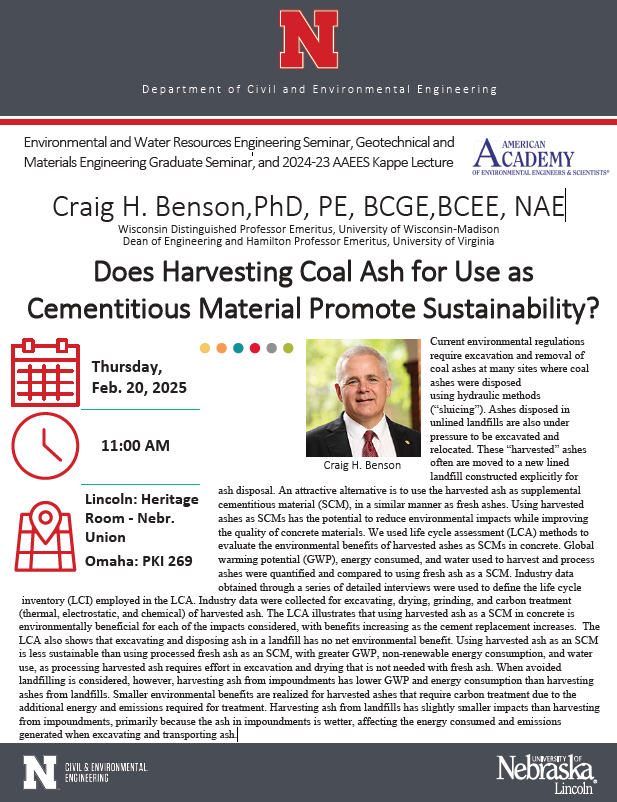
Speaker: Craig H. Benson, PhD, PE, BCGE, BCEE, NAE
When: Thursday, February 20th, 11:00am
Where: Heritage Room, Nebraska Union (Lincoln), PKI 269 (Omaha)
Title: Does Harvesting Coal Ash for Use as Cementitious Material Promote Sustainability?
Abstract: Current environmental regulations require excavation and removal of coal ashes at many sites where coal ashes were disposed
using hydraulic methods (“sluicing”). Ashes disposed in unlined landfills are also under pressure to be excavated and relocated. These “harvested” ashes often are moved to a new lined landfill constructed explicitly for ash disposal. An attractive alternative is to use the harvested ash as supplemental cementitious material (SCM), in a similar manner as fresh ashes. Using harvested ashes as SCMs has the potential to reduce environmental impacts while improving the quality of concrete materials. We used life cycle assessment (LCA) methods to evaluate the environmental benefits of harvested ashes as SCMs in concrete. Global warming potential (GWP), energy consumed, and water used to harvest and process ashes were quantified and compared to using fresh ash as a SCM. Industry data obtained through a series of detailed interviews were used to define the life cycle inventory (LCI) employed in the LCA. Industry data were collected for excavating, drying, grinding, and carbon treatment (thermal, electrostatic, and chemical) of harvested ash. The LCA illustrates that using harvested ash as a SCM in concrete is environmentally beneficial for each of the impacts considered, with benefits increasing as the cement replacement increases. The LCA also shows that excavating and disposing ash in a landfill has no net environmental benefit. Using harvested ash as an SCM is less sustainable than using processed fresh ash as an SCM, with greater GWP, non-renewable energy consumption, and water use, as processing harvested ash requires effort in excavation and drying that is not needed with fresh ash. When avoided landfilling is considered, however, harvesting ash from impoundments has lower GWP and energy consumption than harvesting ashes from landfills. Smaller environmental benefits are realized for harvested ashes that require carbon treatment due to the additional energy and emissions required for treatment. Harvesting ash from landfills has slightly smaller impacts than harvesting from impoundments, primarily because the ash in impoundments is wetter, affecting the energy consumed and emissions generated when excavating and transporting ash.